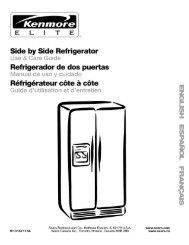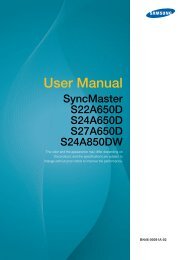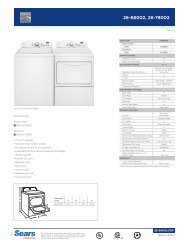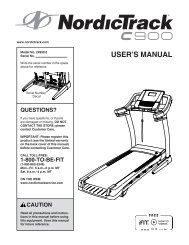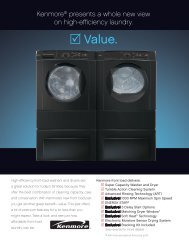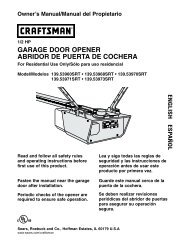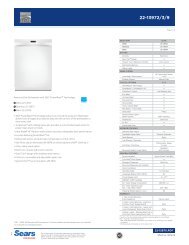Kenmore - Sears
Kenmore - Sears
Kenmore - Sears
Create successful ePaper yourself
Turn your PDF publications into a flip-book with our unique Google optimized e-Paper software.
Solutionsto Common Dishwashing Problems<br />
Before calling for service, review this list. It may save you both time and expense. This<br />
list includes common experiences that are not the result of defective workmanship or<br />
material in your dishwasher.<br />
Food Soils Left on Dishes<br />
• Choose another cycle for longer washing time.<br />
• Check rack loading section for proper loading--avoid<br />
nesting items.<br />
• Home water pressure may be too low--should be 20 to<br />
120 pounds per square inch (psi).<br />
• Check incoming water temperature. It should be 120°F<br />
(49°C). (See Factors Affecting Performance.)<br />
• Check water hardness. For extremely hard water, it<br />
may be necessary to install a water softener. (See<br />
Detergent Chart.)<br />
• Use flesh detergent.<br />
Check to make sure funnel in top rack is not blocked.<br />
Make sure items are not blocking the spray arms,<br />
preventing them from rotating.<br />
Dishes not Dry<br />
• Select HEAT DRY option.<br />
• Make sure the rinse aid dispenser is filled.<br />
• Increase the amount of rinse aid. (See Rinse Aid.)<br />
• Check the incoming water temperature. It should be<br />
120°F (49°C).<br />
• Check for proper loading--avoid nesting items.<br />
• Plastic items may need to be towel dried.<br />
• Cups with a concave bottom will collect water.<br />
Glassware/Flatware Spotted or Cloudy<br />
• Check water hardness. For extremely hard water, it<br />
may be necessary to install a water softener. (See<br />
Dishwasher Dispenser & Detergents.)<br />
• Water temperature may be low. Avoid extremely low<br />
or high temperatures. (See Factors Affecting<br />
Performance.)<br />
• Avoid overloading and improper loading. (See<br />
Preparing and Loading Dishes.)<br />
• Use fresh detergent. Old detergent is ineffective.<br />
• Make sure rinse aid dispenser is filled.<br />
• Check to see that proper amount of detergent is being<br />
used for cycle selected. Also, check phosphate level.<br />
(See Detergent Usage Guide.)<br />
• Home water pressure may be too low--it should be 20<br />
to 120 pounds per square inch (psi).<br />
13<br />
Dishware Chipped<br />
• Load with care and do not overload. (See Preparing<br />
and Loading Dishes.)<br />
• Place delicate items in top rack.<br />
• Place glasses securely against pins and not over pins.<br />
• Load items so they are secure and don't jar loose when<br />
moving racks in and out. Move racks in and out slowly.<br />
• Make sure tall glasses and stemware will clear top of<br />
tub when rack is pushed in.<br />
• Fine antique china and crystal should be hand-washed.<br />
Dishware Stained or Discolored<br />
• Tea and coffee can stain cups. Remove the stains by<br />
hand washing in a solution of 1/2 cup (120 ml) bleach<br />
and one quart (1 L) of warm water. Rinse thoroughly.<br />
• Iron deposits in water can cause a yellow or brown<br />
film. A special filter installed in the water supply line<br />
will correct this problem. (See Removing Spots and<br />
Film.)<br />
• Aluminum utensils can leave gray/black marks when<br />
they rub against other items. Load properly.<br />
• Certain high acid foods can cause discoloration of<br />
stainless steel and plastics if allowed to sit for a long<br />
period.<br />
• Mixing stainless steel and silver utensils in silverware<br />
basket can cause pitting of the stainless steel blades.<br />
Avoid mixing stainless steel and silver.<br />
Etching<br />
• Using too much detergent in soft or softened water<br />
causes this film that cannot be removed.<br />
• Adjust the amount of detergent based on the water<br />
hardness. (Check Detergent Usage Guide.)<br />
• Lower the water temperature.<br />
Detergent Left in Cups<br />
• Detergent may be old. Discard and use fresh detergent.<br />
• Be sure water action can reach the dispenser.<br />
• Check to see if cycle has been completed.<br />
• Make sure items do not prevent the detergent dispenser<br />
from opening.



